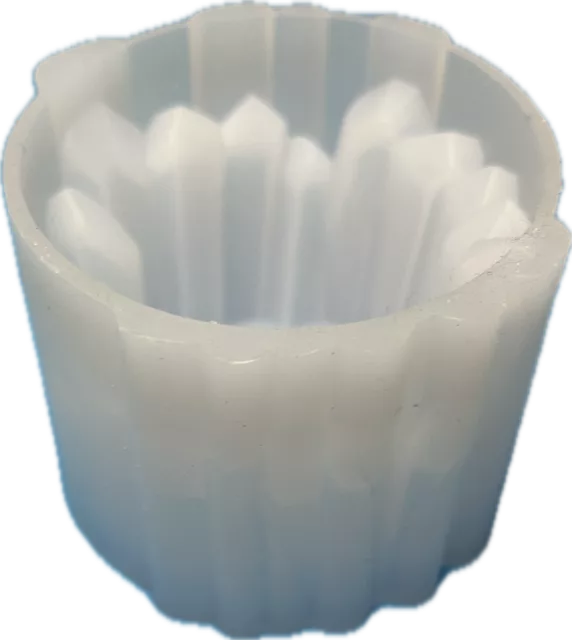How to Choose Your First Candle Mold Project: Start Simple, Stay Safe
Introduction to Molds for a Creative Craft with Products You Can Use
If you’re just starting out with mold making and have chosen candles as your first project, a candle mold and final product, you’ve made a great choice. They’re practical, small-scale, easy to demold, and the results can be surprisingly satisfying—especially when you get to enjoy or gift the candles you’ve made. This guide is designed to help you pick the right model, understand the safety considerations when preparing it for a rubber mold, and answer some common beginner questions. While there are many ways to make candles, this guide focuses solely on mold-making, not the wax-pouring process (we’ll point you to that separately).

This post came about because I realized how many aspects of mold making I now do automatically after more than 30 years of experience in molded product manufacturing. Even with that background, I still plan key parts of each new project, so I can only imagine how overwhelming this may seem the first time around. Whether you want to create candles for fun, start a small business, or learn foundational techniques for more complex castings, this beginner-friendly post will give you a solid head start.
Why Candles Are Ideal for Beginners
A candle mold checks all the boxes for ease of learning and affordability. Here’s why they’re the perfect starting point for your mold-making journey:
- Compact and Manageable: A candle mold is typically small, meaning you’ll use less silicone and reduce the cost and scale of any mistakes.
- Straightforward Shapes: Many candles are cylindrical or symmetrical, which simplifies the mold-making process—no complicated vents or multi-part assemblies required.
- Affordable Materials: You can create models from simple, inexpensive, or even recycled items, keeping costs low.
- Reusable End Products: A well-made candle mold can produce candles, or even soaps, small resin or concrete pieces, depending on the design.
- Foundational Skills: From model prep to candle mold box construction, every step teaches core skills that will benefit future projects.
Choosing Your First Candle Model: What to Look For
Simplicity is your friend when selecting your first model—the object you’ll mold. Aim for the following:
- Avoid Undercuts: Choose shapes that won’t trap the rubber or lock into themselves. Sides and edges should face upward or outward.
- Smooth Surfaces: Highly textured models (like fur or detailed patterns) are much harder to mold and demold. Save those for later.
- Sturdy Materials: Use hard plastic, wood, or glass. Avoid wax models for your first attempt—they’re fragile and prone to deformation.
Great First Model Ideas:
- A classic pillar-style candle (e.g., church candle)
- A small decorative bottle or glass jar
- A clay-sculpted cylinder or cone (seal it well for best results)
- A child’s toy block or simple figurine (non-licensed)
Avoid soft, crumbly, or porous items unless you know how to seal and reinforce them.
Preparing the Model Safely: What Beginners Should Know
Model preparation is just as critical as choosing the right silicone. Here’s how to get your model ready for its candle mold:
- Seal the Surface: Use a spray sealer, suitable acrylic paint, shellac, or PVA glue to close pores in materials like clay, wood, or plaster.
- Avoid Fragile Shapes: If your model has thin overhangs or delicate tips, it’s better to save it for later. These parts often break or trap air.
- Flat, Stable Base: Make sure the bottom is flat enough to secure firmly to your working surface. Once mounted, caulk or seal the edge to stop leaks.
- Mount Securely: Use hot glue or reusable putty to fix the model inside the mold box—it must not shift during pouring.
Beginner Safety Tips:
- Work in a well-ventilated area, especially when sealing, gluing, or spraying.
- Wear gloves when handling sealers, sharp tools, or hot glue.
- Avoid superglue on porous surfaces—it can overheat or stain and makes repositioning difficult.
- Always cut away from your body when using knives, scalpels, or chisels, and store tools safely.
Building a Candle Mold Box: Simple Techniques That Work
A mold box is the container that holds your model and the liquid silicone during curing. In many cases these mold boxes are used in continued production runs as mother molds to protect and keep the mold in line. When crafting, you can make one from many everyday materials—no special purchases required. But keep in mind and assess the candle’s orientation: since candles are typically poured from what becomes the bottom, your mold should be built upright with the base facing up.
Beginner-Friendly Candle Mold Box Materials:
- Plastic tubs with straight sides (good for one-piece molds)
- Lego walls on a plastic base (reusable and adjustable)
- Foam board hot glued into a tight square or cylinder
- Plywood boxes for long-term or repeated use (precise, durable)
Make sure your mold box is:
- Slightly larger than your model on all sides (aim for 3/8″ to 1/2″ clearance)
- Leak-proof and level—seal gaps with caulk, hot glue or clay
- Easy to dismantle or cut open when demolding
Use mold release spray if you plan to reuse the box or if you’re unsure about compatibility.
Quick Overview: What You’ll Need for Pouring a Silicone Candle Mold
This guide doesn’t cover the full pouring process, but here’s what you’ll need on hand:
- Silicone Rubber Only: Choose a heat-resistant version, ideally labeled food-safe. Beginner kits with a 1:1 mix ratio are easiest.
- Mixing Tools: Disposable cups, wooden stirrers, and a clean work surface.
- Digital Scale: Some kits use weight rather than volume—check your product’s instructions.
- Ventilation: Essential if using silicones with strong odours or additives.
- Release Agent: Optional, but helpful for tricky surfaces or reused models.
We’ll take you step-by-step through pouring in our next post.
Candle Mold: Common Beginner Questions
Q: Can I use an actual candle to make a candle mold?
A: Yes, but be cautious. Wax is fragile—chill the candle first and avoid thin or soft details unless reinforced.
Q: What if my model has small dents or texture?
A: Fill dents with clay or putty, or embrace the texture—but always remember that silicone replicates any surface detail very accurately, and it will reflect in the final product.
Q: Do I need a release agent on my model?
A: Possibly. Smooth, sealed surfaces often don’t need it. Porous or tacky surfaces usually do.
Q: How can I reduce bubbles in my mold?
A: Pour the silicone slowly in a high, thin stream to pop bubbles. Gently tap or vibrate the mold box to release trapped air. A quick pass with a heat gun can also help pop surface bubbles.
Q: Can I reuse the same mold for other materials?
A: Absolutely. Silicone molds can handle wax, resin, soap, even cement. Just clean thoroughly and apply the correct release agent for each.
Q: What if I mess up? Can I reuse the silicone?
A: No, cured silicone can’t be melted down. But you can chop up failed molds and use them as filler for larger future molds.
Wrap-Up: Start Small, Learn Big
Making your first mold doesn’t need to be complicated or expensive. A simple candle project allows you to learn core skills, develop confidence, and make something useful. With some planning, safety precautions, and patience, your first candle mold can be a rewarding gateway to years of creative casting.
Remember: the secret to success is in the prep. Keep things simple, review your steps, and don’t rush the process. You’ll be amazed at what you can create—even with basic tools and materials.
In the next guide, we’ll show you how to pour your silicone mold the right way—minimizing bubbles, ensuring a full cure, and getting professional results.
Stay creative—and stay safe!

Thank you or this. I was in San Diego recently and got to try candle making and enjoyed it so much I thought I must really try it when I get home. There are some weird and wonderful molds out there, but I will stick to your advice of keeping it simple so that I don’t make my life difficult.
I can see how easily air could be trapped inside the more intricate molds, and it is so much easier to get the candle out of a straight and thick mold. I loved experimenting with the different shades and colors. Now I just need to get my handle on getting the wick in the middle.
Hi Michel,
I am glad you found the post interesting and even helpful, air bubbles in your mold is one thing, but in your finished piece- even worse.
Rob